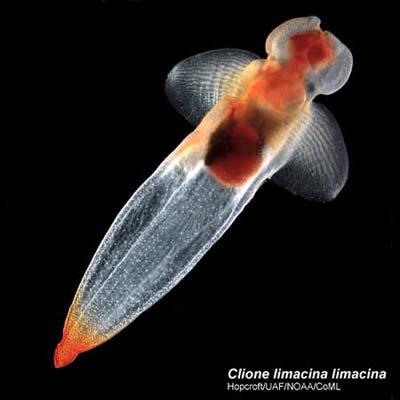Source: Xinhua
02-17-2009 12:18
Special Report: Tech MaxBEIJING, Feb. 16 (Xinhuanet) -- It has been determined that at least 235 species live in both polar seas despite the 8,000 miles (13,000 km) between the ends of the Earth and a DNA analysis is underway to confirm if they are in fact identical, researchers announced Sunday.
 |
| The shell-less pteropod or swimming snail (Clione limacina), found in both Arctic and Antarctic waters, is seen in this undated handout. At least 235 types of cold-loving creatures thrive in both Arctic and Antarctic seas, puzzling scientists about how they got to both ends of the earth, a study showed on Sunday. (Xinhua/Reuters Photo) |
How some of the creatures wound up at the top and bottom of the planet is a mystery. Distance and habitat divisions — such as warm water between the two regions — are among the things that can separate creatures and lead to new species.
The researchers also found evidence that cold water species are moving toward the poles to escape rising ocean temperatures. The project has also returned dramatic photos of species as wide-ranging as ice-loving sand fleas and an antifreeze Antarctic fish that can withstand temperatures that would freeze other fish.
Among the beasts that call both polar seas home are marathon migrators such as grey whales and birds. But the researchers, working on the ongoing Census of Marine Life, also found bipolar worms, crustaceans, and angelic snail-like pteropods.
"The polar seas, far from being biological deserts, teem with an amazing quantity and variety of life," said Ian Poiner, chair of the Census Scientific Steering Committee for the project.
Biologists from several nations have for the past two years worked on the census, at times braving 48-foot (16-meter) waves and frigid conditions.
"Only through the cooperation of 500 people from more than 25 countries could the daunting environmental challenges be overcome to produce research of such unprecedented scale and importance," Poiner said. "And humanity is only starting to understand the nature of these regions."
The team estimates there are 7,500 animals in the Antarctic and 5,500 in the Arctic, and the total number of marine life species known globally is about 250,000. That number may eventually rise to about a million, scientists say.
The National Science Foundation estimates there could be anywhere from 5 million to 100 million species of life on the planet, but science has only identified about 2 million.
-- Click for more news in Tech Max >>
